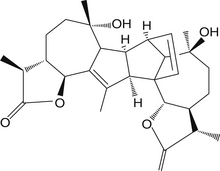Chapter 66 Artemisia absinthium (Wormwood)
Artemisia absinthium (family: Asteraceae)
 Chemical Composition
Chemical Composition
The aerial parts of wormwood contain two components considered most important to its medicinal activity: 0.15% to 0.4% volatile oil and 0.2% to 1.5% sesquiterpene lactones.1 The volatile oil is most notorious for its content of the terpenoids α- and β-thujone, given the potential neurotoxicity of these compounds. Alpha-thujone is believed to be much more toxic and is present as 0.53% to 1.22% of the volatile oil compared with 17.5% to 42.3% of β-thujone.2 Several chemotypes of wormwood depend on growing environment, and only certain ones contain thujone—others have trans-sabinyl acetate, cis-epoxyocimen, or chrysanthenyl acetate instead.1 Major sesquiterpene lactones present are absinthin, artabsin, matricin, and anabsinthin (Figures 66-1 to 66-3).
 History and Folk Use
History and Folk Use
The medicinal aspects of most of the history of wormwood are unfortunately overshadowed by development in the late eighteenth century of absinthe. The standard account of the rise of absinthe, a liqueur derived in part from wormwood, begins with French expatriate Pierre Ordinaire, who allegedly developed the first absinthe recipe in 1792 in Switzerland.3 Absinthe schnapps, absinthe-infused ale (known as “purl”), absinthe-infused wine, and other absinthe-containing beverages had been in use since Dioscorides’ time and probably before. Absinthe was apparently made by infusing wormwood, garden angelica root, anise fruit, and marjoram herb in ethanol; distilling them; and adding other flavorings, including volatile oils.3 The resulting product was bright green and intensely bitter, formed a white precipitate, and had a high alcohol content (50% to 80%).4
Henri Dubied and his son-in-law Henri Louis Pernod purchased Ordinaire’s formula and began producing large quantities of absinthe at the Pernod Fils distillery.4 One client for their product was the French military, which invaded Algeria from 1844 to 1847 and issued absinthe regularly to the troops to help prevent and treat dysentery. These troops apparently returned to France with a taste for absinthe and increased the popularity of the beverage.
Although originally absinthe was most popular with people in the lower classes, it caught on among the intelligentsia in the 1860s and 1870s, a time of cultural ferment, particularly in Paris. Parisians would gather in cafes to sip absinthe, often diluted by pouring cold water over a sugar cube held in a perforated spoon into a glass containing a shot of absinthe.5 Numerous famous artists of the time drank absinthe regularly, including Vincent van Gogh, whose insanity has been blamed (without proof) on his absinthe habit.
The growing popularity of absinthe, combined with a fire at the Pernod Fils distillery in 1901, led to a surge of absinthe-like products on the market. Unfortunately, these imitation products were often made as cheaply as possibly by simply mixing volatile oils with alcohol, adding various coloring agents to give the appropriate green hue (including copper sulfate), and antimony chloride to create the appearance of the white precipitate formed in true absinthe.3 At the same time, a new phenomenon termed absinthism was becoming widely known. This syndrome was a result of chronic absinthe overindulgence and included bursts of violent aggressiveness followed by prolonged depression, trembling, hallucinations, seizures, and death.5 However, the presence of adulterated, low-quality, high-ethanol absinthe products on the market and the inability to distinguish the effects of ethanol abuse from those of other compounds in the mixture made it difficult to be certain exactly what was causing absinthism. The levels of the purported neurotoxin thujone in true absinthe were 2 to 4 mg per drink, far below the 10 mg/kg levels needed to induce neurologic damage in numerous animal experiments.6 In the early twentieth century, absinthe was banned in most of Europe and the United States. Absinthe, usually with limits on thujone content, is now legal again in many places, including Europe and the United States.
The Eclectics regarded wormwood as a digestive tonic useful in atonic dyspepsia, as a potential treatment for roundworms, and for topical application to sprains and bruises.7 The dangers of absinthism were well known to these turn-of-the-century American natural physicians, but they did not seem clear on the various problematic elements in the history of absinthe discussed previously.
 Pharmacology
Pharmacology
Digestive Effects
In a controlled clinical trial, wormwood tincture and thujone-free wormwood tincture were both shown to significantly increase bile and pancreatic enzyme secretion in humans compared with water.8 The levels of secretion were assessed intraduodenally. These effects seem to be common to many bitter herbs that contain sesquiterpene lactones. Wormwood extract had a modest antidiarrheal effect in one rat model unrelated to infection.8a
Stay updated, free articles. Join our Telegram channel

Full access? Get Clinical Tree





